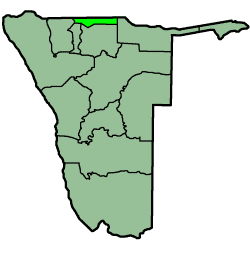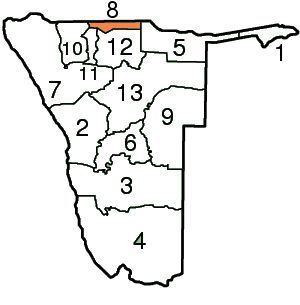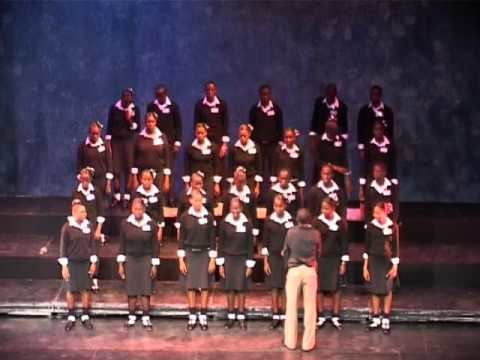Country Namibia Capital | Area 10,706 km2 Governor | |
 | ||
Map of Ohangwena Region
Ohangwena is one of the fourteen regions of Namibia, its capital is Eenhana. The northern and western parts of the region are the most densely populated of this essentially subsistence agricultural region in which small scale mahangu cultivation and the keeping of cattle form the predominant activities. Although the region depends on rain fed agriculture, other crops can be established under intensive cultivation.
Contents
- Map of Ohangwena Region
- Oshikango main road ohangwena region namibia
- Namibian president motocrade in ohangwena region
- Economy and infrastructure
- Demographics
- Politics in Ohangwena region
- Villages
- References

The main settlements in the region straddle the good paved road from the Angolan border to Ondangwa, where it joins the Oshakati-Tsumeb trunk road. The eastern part of the region possesses good grazing land, but the shortage of water and poor communications render it uninhabitable at present. There is a tarred road from Onhuno to Okongo that was recently completed, it is thought to greatly increase the area's agricultural potential.

In the north, Ohangwena borders Angola: the Cunene Province, except for a small border with Cuando Cubango Province in the far northeast. Domestically, it borders the following regions:
It is traversed by the northwesterly line of equal latitude and longitude.
The region comprises twelve constituencies:
Oshikango main road ohangwena region namibia
Namibian president motocrade in ohangwena region
Economy and infrastructure
Ohangwena has 234 schools with a total of 90,703 pupils.
Demographics
According to the Namibia 2001 Population and Housing Census, Ohangwena had a population of 228,384 (124,823 females and 103,556 males or 83 males for every 100 females) growing at an annual rate of 2.4%. The fertility rate was 5.3 children per woman. 1% lived in urban areas while 99% lived in rural areas, and with an area of 10,703 km2, the population density was 21.3 persons per km2. By age, 15% of the population was under 5 years old, 33% between 5–14 years, 41% between 15–59 years, and 9% 60 years and older. The population was divided into 35,958 households, with an average size of 6.3 persons. 60% of households had a female head of house, while 40% had a male. For those 15 years and older, 59% had never married, 17% married with certificate, 9% married traditionally, 4% married concensually, 4% were divorced or separated, and 6% were widowed.
The most commonly spoken languages at home were Oshiwambo languages, spoken in 97% of households. For those 15 years and older, the literacy rate was 79%. In terms of education, 53% of girls and 47% of boys between the ages of 6-15 were attending school, and of those 15 years and older, 51% had left school, 23% were currently at school, and 23% had never attended.
In 2001 the employment rate for the labor force (43% of those 15+) was 64% employed and 36% unemployed. For those 15+ years old and not in the labor force (53%), 35% were students, 41% homemakers, and 24% retired, too old, etc. According to the 2012 Namibia Labour Force Survey, unemployment in the Ohangwena Region stood at 34.6%. The two studies are methodologically not comparable.
Among households, 78% had access to safe water but only 11% to improved sanitation (toilet facilities). 4% of the households have electricity for lighting, 72% access to radio, and 94% had wood or charcoal for cooking. In terms of households' main sources of income, 52% derived it from farming, 13% from wages and salaries, 5% cash remittances, 8% from business or non-farming, and 20% from pension.
For every 1000 live births there were 56 female infant deaths and 56 male. The life expectancy at birth was 45 years for females and 43 for males. Among children younger than 15, 5% had lost a mother, 11% a father, and 2% were orphaned by both parents. 5% of the entire population had a disability, of which 22% were deaf, 32% blind, 11% had a speech disability, 15% hand disability, 26% leg disability, and 5% mental disability.
Politics in Ohangwena region
The governor of Ohangwena Region is Usko Nghaamwa of the ruling SWAPO party. The region is one of the regions where many Namibian politicians are from, including former President Hifikepunye Pohamba, Hidipo Hamutenya (President of the Rally for Democracy and Progress, RDP), Minister of Environment and Tourism Pohamba Shifeta, founding member of SWAPO Mzee Kaukungwa and several other ministers and high-profile politicians.
A significant amount of fighting occurred in the region during the Namibian War of Independence. Just as Namibia was set for independence, fighting broke out on April 1, 1989 in the region between People's Liberation Army of Namibia combatants and soldiers in the occupying South African Defence Force. The resulting "9 day war" left many dead.
In the 2015 regional elections SWAPO won all twelve constituencies with 90% or more. The RDP managed to name opposition candidates in all constituencies but one, and the Democratic Turnhalle Alliance (DTA) in two.
